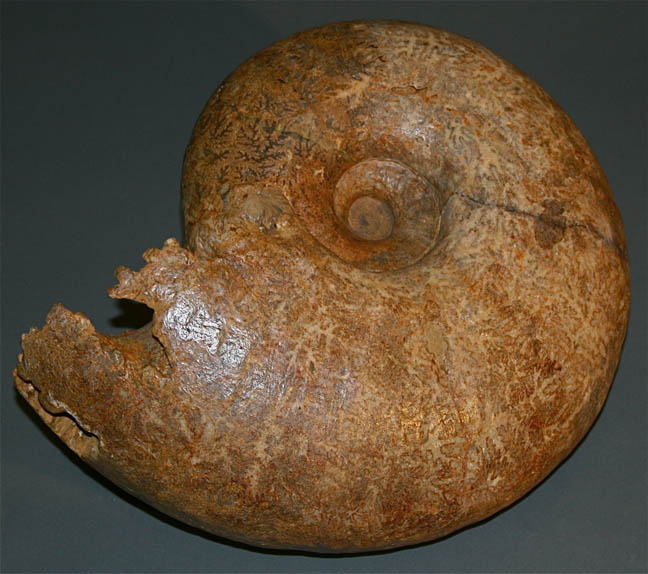

Title: Very Rare Large Robust Fossil Ammonite
Shipping: $59.00
Artist: N/A
Period: Antiquity
History: N/A
Origin: N/A
Condition: Museum Quality
Item Date: between 240 - 65 milli
Item ID: 3220
Wow, Few of the ammonites reach a size exceeding (9 inches) in diameter, this one is over that! This is an example of a huge world class AAA grade Ammonite Specimen! Gorgeous! Vary hard to find one this big! Ammonite is a fossilized animal which was present on Earth in Eons past; it has similar structure to a snail. Ammonite is capable of splitting sunlight into every color imaginable. It is a protective stone offering stability and structure to ones life. It transforms negativity into a smooth flowing positive energy! Ammonites are perhaps the most widely known fossil, possessing the typically ribbed spiral-form shell. These creatures lived in the seas between 240 - 65 million years ago, when they became extinct along with the dinosaurs. The name 'ammonite' (usually lower-case) originates from the Greek Ram-horned god called Ammon. Ammonites belong to a group of predators known as cephalopods, which includes their living relatives the octopus, squid, cuttlefish and nautilus. The Size: Few of the ammonites occurring in the lower and middle part of the Jurassic period reach a size exceeding 23 centimetres (9 inches) in diameter. Much larger forms are found in the later rocks of the upper part of the Jurassic and the lower part of the Cretaceous, such as Titanites from the Portland Stone of Jurassic of southern England, which is often 53 centimetres (2 feet) in diameter, and Parapuzosia seppenradensis of the Cretaceous period of Germany, which is one of the largest known ammonites, sometimes reaching 2 metres (6.5 feet) in diameter. The largest documented North American ammonite is Parapuzosia bradyi from the Cretaceous with specimens measuring 137 centimetres (4.5 feet) in diameter, although a new 2.3-metre (7.5-foot) British Columbian specimen, if authentic, would appear to trump even the European champion.
Link: http://en.wikipedia.org/wiki/Ammonite
Ammonites, as they pertain specifically to the order Ammonitida, are an extinct group of marine animals belonging to the cephalopod subclass Ammonoidea. They are excellent index fossils, and it is often possible to link the rock layer in which they are found to specific geological time periods. The closest living relative of the Ammonitida is not the modern Nautilus, which they somewhat outwardly resemble, but rather the subclass Coleoidea (octopus, squid, and cuttlefish). Their fossil shells usually take the form of planispirals, although there were some helically-spiraled and non-spiraled forms (known as "heteromorphs"). Their name came from their spiral shape as their fossilized shells somewhat resemble tightly-coiled rams' horns. Pliny the Elder (d. 79 A.D. near Pompeii) called fossils of these animals ammonis cornua ("horns of Ammon") because the Egyptian god Ammon (Amun) was typically depicted wearing ram's horns. Often the name of an ammonite genus ends in -ceras, which is Greek (κέρας) for "horn" (for instance, Pleuroceras). Because ammonites and their close relatives are extinct, little is known about their way of life. Their soft body parts are very rarely preserved in any detail. Nonetheless, much has been worked out by examining ammonoid shells and by using models of these shells in water tanks. Many ammonoids probably lived in the open water of ancient seas, rather than at the sea bottom. This is suggested by the fact that their fossils are often found in rocks that were laid down under conditions where no bottom-dwelling life is found. Many of them (such as Oxynoticeras) are thought to have been good swimmers with flattened, discus-shaped, streamlined shells, although some ammonoids were less effective swimmers and were likely to have been slow-swimming bottom-dwellers. Ammonites and their kin probably preyed on fish, crustaceans and other small creatures, while they themselves were preyed upon by such marine reptiles as mosasaurs. Fossilized ammonoids have been found showing teeth marks from such attacks. They may have avoided predation by squirting ink, much like modern cephalopods; ink is occasionally preserved in fossil specimens. The soft body of the creature occupied the largest segments of the shell at the end of the coil. The smaller earlier segments were walled off and the animal could maintain its buoyancy by filling them with gas. Thus the smaller sections of the coil would have floated above the larger sections. The chambered part of the ammonite shell is called a phragmocone. The phragmocone contains a series of progressively larger chambers, called camerae (sing. camera) that are divided by thin walls called septa (sing. septum). Only the last and largest chamber, the body chamber, was occupied by the living animal at any given moment. As it grew, it added newer and larger chambers to the open end of the coil. A thin living tube called a siphuncle passed through the septa, extending from the ammonite's body into the empty shell chambers. Through a hyperosmotic active transport process, the ammonite emptied water out of these shell chambers. This enabled it to control the buoyancy of the shell and thereby rise or descend in the water column. A primary difference between ammonites and nautiloids is that the siphuncle of ammonites (excepting Clymeniina) runs along the ventral periphery of the septa and camerae (i.e., the inner surface of the outer axis of the shell), while the siphuncle of nautiloids runs more or less through the center of the septa and camerae.